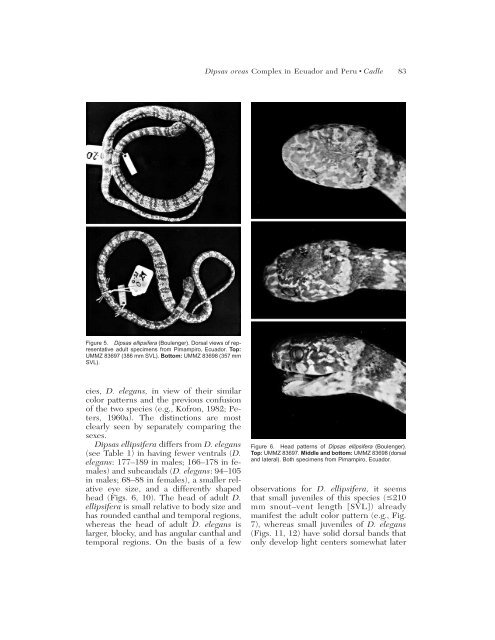systematics of snakes of the dipsas oreas complex - BioOne
systematics of snakes of the dipsas oreas complex - BioOne
systematics of snakes of the dipsas oreas complex - BioOne
You also want an ePaper? Increase the reach of your titles
YUMPU automatically turns print PDFs into web optimized ePapers that Google loves.
Dipsas <strong>oreas</strong> Complex in Ecuador and Peru • Cadle 83<br />
Figure 5. Dipsas ellipsifera (Boulenger). Dorsal views <strong>of</strong> representative<br />
adult specimens from Pimampiro, Ecuador. Top:<br />
UMMZ 83697 (386 mm SVL). Bottom: UMMZ 83698 (357 mm<br />
SVL).<br />
cies, D. elegans, in view <strong>of</strong> <strong>the</strong>ir similar<br />
color patterns and <strong>the</strong> previous confusion<br />
<strong>of</strong> <strong>the</strong> two species (e.g., K<strong>of</strong>ron, 1982; Peters,<br />
1960a). The distinctions are most<br />
clearly seen by separately comparing <strong>the</strong><br />
sexes.<br />
Dipsas ellipsifera differs from D. elegans<br />
(see Table 1) in having fewer ventrals (D.<br />
elegans: 177–189 in males; 166–178 in females)<br />
and subcaudals (D. elegans: 94–105<br />
in males; 68–88 in females), a smaller relative<br />
eye size, and a differently shaped<br />
head (Figs. 6, 10). The head <strong>of</strong> adult D.<br />
ellipsifera is small relative to body size and<br />
has rounded canthal and temporal regions,<br />
whereas <strong>the</strong> head <strong>of</strong> adult D. elegans is<br />
larger, blocky, and has angular canthal and<br />
temporal regions. On <strong>the</strong> basis <strong>of</strong> a few<br />
Figure 6. Head patterns <strong>of</strong> Dipsas ellipsifera (Boulenger).<br />
Top: UMMZ 83697. Middle and bottom: UMMZ 83698 (dorsal<br />
and lateral). Both specimens from Pimampiro, Ecuador.<br />
observations for D. ellipsifera, it seems<br />
that small juveniles <strong>of</strong> this species (210<br />
mm snout–vent length [SVL]) already<br />
manifest <strong>the</strong> adult color pattern (e.g., Fig.<br />
7), whereas small juveniles <strong>of</strong> D. elegans<br />
(Figs. 11, 12) have solid dorsal bands that<br />
only develop light centers somewhat later







